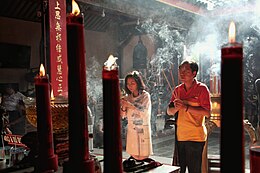
Back إندونيسيون صينيون Arabic Inmigración china en Indonesia Spanish اندونزیاییهای چینی Persian Indonesian kiinalaiset Finnish Chinois d'Indonésie French Orang Tionghoa Indonesia ID Wong Tionghoa-Indonésia JV 중국계 인도네시아인 Korean Urang Cino Indonesia MIN Индонез дахь хятадууд Mongolian
Orang Tionghoa Indonesia 印度尼西亞華人 印度尼西亚华人 | |
|---|---|
 Performing rituals for the 2020 Chinese New Year's eve in Indonesia | |
| Total population | |
| 2,832,510 (2010) De jure estimation[1] 3,280,000 (2020) De facto estimation[2] | |
| Regions with significant populations | |
Throughout Indonesia (mostly in Java, Sumatra, Riau Islands, Bangka Belitung Islands and Kalimantan, with a significant population in Eastern Indonesia, especially in parts of Sulawesi and the Maluku Islands) Significant diaspora populace in: | |
| Languages | |
| Primarily Indonesian (lingua franca) Mother tongue languages Indonesian, Betawi, Javanese, Sundanese, Minangkabau, Batak, Acehnese, Balinese, Malay and its varieties and other languages of Indonesia Mandarin, Hokkien, Hakka, Teochew, Cantonese, Hokchew, Henghwa, Hainanese, Taishanese and other varieties of Chinese. | |
| Religion | |
Christianity 47% (Protestant 27% and Roman Catholic 20%), Buddhism 45% (Mahayana and Theravada), Sunni Islam 5%, Confucianism 3%, Hinduism, and others.
| |
| Related ethnic groups | |
| Chinese Indonesians | |||||||||||||||||||||||||||||||||||
|---|---|---|---|---|---|---|---|---|---|---|---|---|---|---|---|---|---|---|---|---|---|---|---|---|---|---|---|---|---|---|---|---|---|---|---|
| Traditional Chinese | 印度尼西亞華人 | ||||||||||||||||||||||||||||||||||
| Simplified Chinese | 印度尼西亚华人 | ||||||||||||||||||||||||||||||||||
| Literal meaning | Indonesian Chinese people | ||||||||||||||||||||||||||||||||||
| |||||||||||||||||||||||||||||||||||
Chinese Indonesians (Indonesian: Orang Tionghoa Indonesia), colloquially Cindo, Chindo or simply Orang Tionghoa or Tionghoa,[7] are Indonesians whose ancestors arrived from China at some stage in the last eight centuries. Chinese Indonesians are the fourth largest community of Overseas Chinese in the world after Thailand, Malaysia, and the United States.
Chinese people and their Indonesian descendants have lived in the Indonesian archipelago since at least the 13th century. Many came initially as sojourners (temporary residents), intending to return home in their old age.[8] Some, however, stayed in the region as economic migrants. Their population grew rapidly during the colonial period when workers were contracted from their home provinces in Southern China. Discrimination against Chinese Indonesians has occurred since the start of Dutch colonialism in the region, although government policies implemented since 1998 have attempted to redress this. Resentment of ethnic Chinese economic aptitude grew in the 1950s as Native Indonesian merchants felt they could not remain competitive. In some cases, government action propagated the stereotype that ethnic Chinese-owned conglomerates were corrupt. Although the 1997 Asian financial crisis severely disrupted their business activities, reform of government policy and legislation removed most if not all political and social restrictions on Chinese Indonesians.
The development of local Chinese society and culture is based upon three pillars: clan associations, ethnic media and Chinese-language schools.[9][10] These flourished during the period of Chinese nationalism in the final years of China's Qing dynasty and through the Second Sino-Japanese War; however, differences in the objective of nationalist sentiments brought about a split in the population. One group supported political reforms in China, while others worked towards improved status in local politics. The New Order government (1967–1998) dismantled the pillars of ethnic Chinese identity in favor of assimilation policies as a solution to the so-called "Chinese Problem".
The Chinese Indonesian population of Java accounts for nearly half of the group's national population. They are generally more urbanized than Indonesia's indigenous population but significant rural and agricultural communities still exist throughout the country. Declining fertility rates have resulted in an upward shift in the population pyramid, as the median age increases. Emigration has contributed to a shrinking population and communities have emerged in more industrialized nations in the second half of the 20th century. Some have participated in repatriation programs to the People's Republic of China, while others emigrated to neighboring Singapore, Malaysia, Taiwan, and Western countries to escape anti-Chinese sentiment.[11] Among the overseas residents, their identities are noticeably more Indonesian than Chinese.[12]
- ^ "Chinese Diaspora".
- ^ "Berapakah Jumlah Sesungguhnya Populasi Tionghoa di Indonesia?". nationalgeographic.grid.id. 5 June 2021. Retrieved 22 August 2023.
- ^ Stephen Gapps. "A Complicated Journey: Chinese, Indonesian, and Australian Family Histories". Australian National Maritime Museum. Archived from the original on 6 May 2018. Retrieved 22 April 2018.
- ^ Terri McCormack (2008). "Indonesians". Dictionary of Sydney. Retrieved 22 April 2018.
- ^ a b Thomas Fuller (12 December 1998). "Indonesia's Ethnic Chinese Find a Haven For Now, But Their Future Is Uncertain: Malaysia's Wary Welcome". The New York Times. Retrieved 22 April 2018.
- ^ "Statistics" (in Chinese). National Immigration Agency, ROC. Retrieved 13 February 2011.
- ^ Kenneth Utama (30 August 2016). "Why it's important to talk about Chinese-Indonesians or Cindo". The Jakarta Post. Retrieved 9 March 2021.
- ^ Wang Gungwu (1996). "Sojourning: the Chinese experience in Southeast Asia". In Anthony Reid (ed.). Sojourners and settlers: histories of Southeast Asia and the Chinese. Honolulu: University of Hawai'i Press. pp. 1–9.
- ^ Suryadinata, Arifin & Ananta 2003, p. 74.
- ^ Hoon 2006, p. 96.
- ^ Joe Cochrane (22 November 2014). "An Ethnic Chinese Christian, Breaking Barriers in Indonesia". The New York Times. Retrieved 22 April 2018.
- ^ Cunningham 2008, p. 104.
© MMXXIII Rich X Search. We shall prevail. All rights reserved. Rich X Search